Recovery Timeframe, Physiotherapy Sessions, Potential Issues in Ankle Fusion Treatment
Ankle fusion surgery is a common procedure used to alleviate pain from end-stage ankle arthritis. The recovery process varies for each individual, but generally spans 12 to 14 weeks.
After the surgery, doctors may advise keeping the ankle elevated above the heart level for 1-2 weeks to prevent swelling. The healing time is influenced by several factors, including the individual's age, health, lifestyle, and the severity of the pre-existing condition. Younger patients and those in good overall health tend to heal more quickly, while older adults or those with comorbidities may experience slower recovery.
Complex or long-standing ankle problems can prolong healing time, as can minimally invasive or keyhole surgeries. Adherence to post-operative care and rehabilitation, weight-bearing progression, and following medical guidance greatly impact healing success and speed. Lifestyle factors such as smoking, poor nutrition, and high stress can negatively affect bone healing and increase complication risk, thereby extending recovery time.
The surgery itself involves the removal of damaged cartilage and the use of screws, pins, rods, or plates to stabilize the joint. Doctors remove damaged cartilage and use these fixatives to fuse the bone joints, effectively eliminating the source of pain.
Recovery involves wearing a cast for 6–12 weeks, with a gradual return to normal activities but often avoidance of running or high-impact activity. A well-structured rehabilitation program focusing on range of motion, strength, gait training, and balance supports optimal healing and function.
Common complications of ankle fusion include bleeding or blood clots, infection at the site of surgery, damage to blood vessels and nerves, issues regarding anesthesia, and the need for revision surgery. In some cases, the bones may fail to fuse (nonunion), necessitating another operation to place a bone graft in the ankle or use a bone stimulator, a device that helps heal fractures more quickly.
People should contact a doctor regularly during their recovery phase to ensure that the fusion of the bones is taking place as per alignment and attend all follow-up appointments and adhere to recovery advice. It's crucial to consult doctors before returning to usual daily activities.
Despite the potential complications, ankle fusion surgery may allow people to achieve a higher quality of life. Study participants have shown significant improvement in their walking speed and stride, and the ability to walk 1,000-3,000 meters on average. Physical therapy may be required as part of the recovery process to regain strength in the ankle and restore motion, starting 10-14 days after the surgery.
In summary, healing time after ankle fusion surgery is influenced by patient-related factors, surgery specifics, and adherence to post-surgical rehabilitation protocols. It's essential to discuss any concerns with a healthcare professional to ensure a successful recovery. For those experiencing pain or symptoms of complications after 4 months of the surgery, immediate consultation with doctors is recommended.
- Physical therapy, focused on regaining strength in the ankle and restoring motion, may be necessary after ankle fusion surgery, commencing around 10-14 days into the recovery process.
- Engaging in a structured rehabilitation program involving range of motion, strength, gait training, and balance exercises can support optimal healing and function after ankle fusion surgery.
- The healing and recovery process following ankle fusion surgery is significantly impacted by patient-related factors such as age, overall health, and adherence to post-operative care (including lifestyle choices like smoking and poor nutrition), in addition to surgery specifics and the severity of pre-existing medical conditions like chronic diseases.




